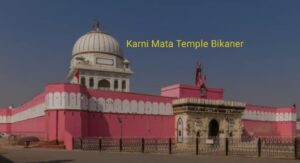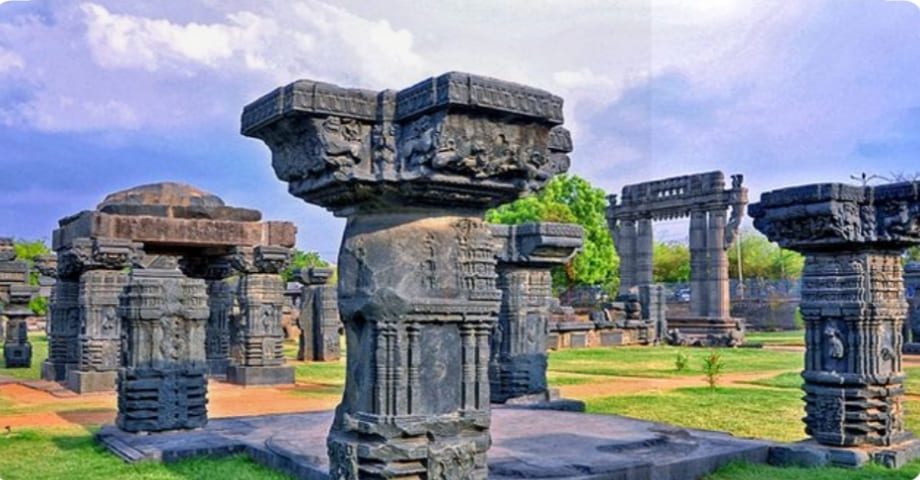Karni Mata Temple Bikaner, a city steeped in history and tradition, is home to some of the most fascinating cultural landmarks in Rajasthan. Among these, the Karni Mata Temple stands out as a unique religious site, famous not only for its architectural grandeur but also for its unusual inhabitants—thousands of rats revered as holy beings. Known as the “Temple of Rats,” Karni Mata Temple is a must-visit for anyone exploring the rich cultural tapestry of Bikaner.

1. Historical Background of Karni Mata Temple Bikaner
Karni Mata, a revered deity in Rajasthan, is believed to be an incarnation of the goddess Durga. She is worshipped across the region for her divine powers and is especially revered by the royal family of Bikaner. The temple dedicated to her in Deshnoke, near Bikaner, was constructed in the early 20th century by Maharaja Ganga Singh. However, the legends associated with Karni Mata date back much further, intertwining with the very fabric of Rajasthan’s folklore.
According to one popular legend, Karni Mata was a miracle worker who lived during the 14th century. When one of her devotees’ sons died, she requested Yama, the god of death, to bring him back to life. Yama refused, but Karni Mata, using her divine powers, reincarnated the boy as a rat, declaring that all her male devotees would be reincarnated as rats until they could be reborn as humans. This legend forms the basis for the temple’s unique relationship with rats, known locally as “kabas.”
2.Karni Mata Temple Bikaner: Architectural Highlights
The Karni Mata Temple is not just a site of religious significance but also an architectural marvel. The temple’s stunning marble façade, with its intricately carved details and silver doors, is a testament to the craftsmanship of the artisans who built it. The influence of both Mughal and Rajput architectural styles is evident in the temple’s design, with its domes, archways, and elaborate carvings.
Inside the temple, the sanctum sanctorum houses the idol of Karni Mata, which is adorned with garlands and offerings from devotees. The floors and walls of the temple are intricately decorated with carvings and paintings that depict scenes from Hindu mythology. The silver doors, a gift from Maharaja Ganga Singh, are particularly noteworthy for their detailed craftsmanship.
3. The Sacred Rats (Kabas)
The most distinctive feature of Karni Mata Temple is its population of over 25,000 rats, which are considered sacred and are believed to be the reincarnated souls of Karni Mata’s devotees. These rats, known as kabas, freely roam the temple, and visitors often find them scurrying underfoot or nibbling at the offerings laid out by devotees.
The temple’s caretakers ensure that the kabas are well-fed and protected. Special food, including grains, milk, and sweets, is prepared daily for the rats, and it is considered highly auspicious to consume food or water that has been nibbled on by them. Among the kabas, the rare white rats are particularly revered, as they are believed to be manifestations of Karni Mata and her four sons. Spotting a white rat is considered a sign of good fortune.

4.Religious Significance and Practices
Karni Mata Temple holds immense religious significance for the people of Rajasthan. Devotees from across the state, and indeed from all over India, visit the temple to seek blessings and to participate in the rituals performed there. The temple is a major pilgrimage site, especially during the festivals of Navratri, when thousands of devotees flock to Deshnoke to offer their prayers.
Rituals at the temple include offering food to the kabas, lighting incense, and chanting prayers. Many devotees also bring offerings of milk, sweets, and other food items for the rats, which are then shared among the worshippers. The belief that these rats are holy beings means that harming them, even accidentally, is considered a grave sin.
The temple also hosts a grand fair twice a year, during the Navratri festival, which draws large crowds. The fair is marked by colorful processions, cultural performances, and religious ceremonies, making it a vibrant celebration of the region’s cultural heritage.
5.Visitor Experience
Visiting Karni Mata Temple is a unique experience that combines spirituality with a sense of wonder. The best time to visit the temple is early in the morning or late in the evening when the temple is less crowded, and the ambiance is peaceful. However, during festivals and religious events, the temple comes alive with the energy and devotion of thousands of pilgrims.
For first-time visitors, it is important to be prepared for the presence of the rats. While they are harmless, their sheer number can be overwhelming. Visitors are advised to wear closed footwear and to be mindful of where they step. Photography is allowed, but it is important to respect the religious sentiments of the devotees and the sanctity of the temple.
Nearby attractions in Bikaner include the Junagarh Fort, the Lalgarh Palace, and the Bhandasar Jain Temple, all of which can be included in a well-rounded itinerary that captures the essence of Bikaner’s rich history and culture.
6.Cultural Impact
Karni Mata Temple is more than just a religious site; it is a cultural icon that plays a significant role in the life of the local community. The temple has shaped the cultural and religious identity of Deshnoke and the surrounding region, influencing local festivals, fairs, and traditions. The temple’s unique practice of revering rats has also made it a popular subject of study for anthropologists and researchers interested in the intersection of religion, culture, and wildlife.
The temple’s influence extends beyond Rajasthan, attracting tourists and devotees from across India and around the world. It has become a symbol of the rich cultural diversity of India, where traditions and beliefs can take on forms that are both fascinating and unexpected.
Conclusion:
Karni Mata Temple in Bikaner is a place where history, culture, and spirituality converge in a unique and compelling way. From its origins in the legends of Karni Mata to its present status as a major pilgrimage site, the temple continues to be a beacon of faith for thousands of devotees. Whether you are drawn by its architectural beauty, its spiritual significance, or its population of sacred rats, a visit to Karni Mata Temple offers an experience that is both profound and unforgettable.
For anyone planning a trip to Bikaner, Karni Mata Temple is a must-see destination that offers a glimpse into the unique and vibrant cultural landscape of Rajasthan.
FAQ:
1.Why is Karni Mata temple famous?
2.When was Karni Mata Ji born?
3.Who is the favorite goddess of Karni Mata?
4.Karni Mata ka kaun sa var hai?
5.Karni Mata Mandir
6.Karni Mata real Photo
7.History of Karni Mata
8.Where is the temple of Karni Mata?
9.Miracle of Karni Mata
10.When was Karni Mata born?

